MAIN ACHIEVEMENTS 2017
Theme 0032-2016-0001 New Functional Materials
Section II. “Physical sciences”, subsection 9. “Material physics: new materials and structures including fullerenes, nanotubes, graphenes, other nanomaterials, and also metamaterials (in the fields of physics and technologies of new functional materials for effective power conversion”. Programs of fundamental scientific researches for state academies of sciences in years 2013-2020
Nickel and Cobalt Sulfates Bicrystals of K2Ni(SO4)2·6H2O/K2Co(SO4)2*6H2O Composition and K2NixCo(1-x)(SO4)2·6H2Mixed Crystals for Solar-Blind UV Filters
The method of growth has been developed and nickel and cobalt sulfates bicrystals of K2Ni(SO4)2·6H2O/K2Co(SO4)2*6H2O composition and K2NixCo(1-x)(SO4)2·6H2mixed crystalshave been obtained for the first time. The crystals demonstrate high transmittance (80%) in the solar-blind spectral region of 200-300 nm UV wavelength range and opacity in other wavelength ranges and allow devices recording radiation in this spectrum range to work in sunlight. Band filtering permits to maintain a high signal/noise ratio and reach giant (up to 108times) gain coefficients in the UV range providing unique equipment sensitivity. UV filters based on the obtained crystals are used for remote inspection of power lines, environmental monitoring of terrestrial and water space, tracking of paths of rocket and missile motion.
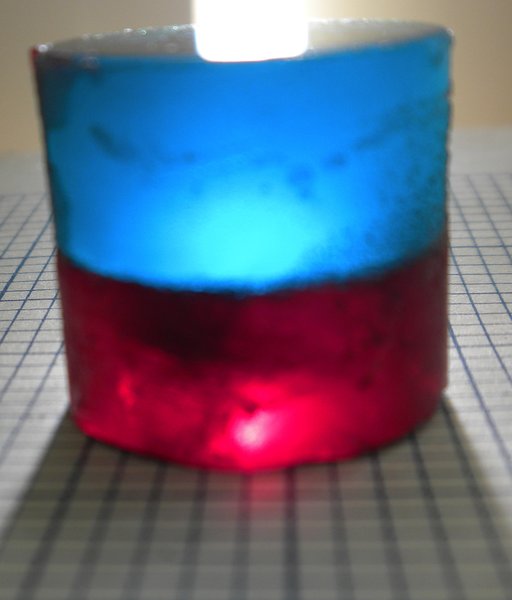
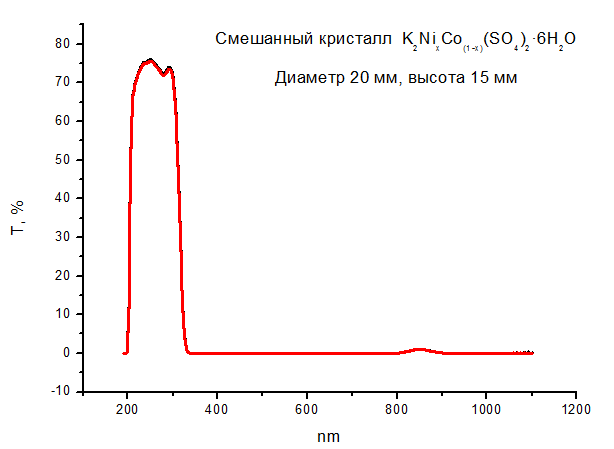
A.A. Zhokhov, V.M. Masalov, G.A. Emelchenko, Laboratory of Crystallization from High-Temperature Solutions of ISSP RAS (associated with A.E. Voloshin's laboratory, FSRC «Crystallography and Photonics» RAS)
- Vladimir M. Masalov, Natalia A. Vasilyeva, Vera L. Manomenova, Andrei A. Zhokhov, Elena B. Rudneva, Alexey E. Voloshin, Gennadi A. Emelchenko.
Growth of mixed K2(Ni,Co)(SO4)2_6H2O crystals under stationary conditions of supercooling and forced convection of the aqueous solution Journal of Crystal Growth 475 (2017) 21–25
Synthesis of High-Purity GaS Crystals
The method for synthesizing of a high-purity single-phase GaS has been developed. The samples of a continuous series of solid solutions GaSe1-xSx (x = 0-1) were produced and their optical properties and phase composition were studied.
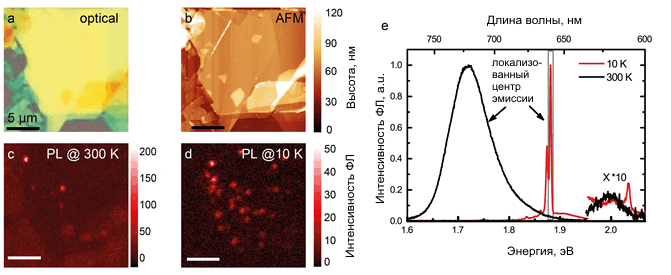
Kolesnikov N.N., Berzigiarova N.S., Borisenko D.N., Borisenko E.B., Gartman V.K., Timonina A.V., Laboratory of Physical-Chemical Basis of Crystallization
Theme0032-2016-0002 Collective Phenomena in Electron and Exciton Systems in Semiconducting Nanoctructures
Section II. “Physical sciences”, subsection 8. “Actual problems of condensed matter physics, including quantum macrophycics, mezoscopy, nanostructure physics, spintronics, superconductivity”. Programs of fundamental scientific researches for state academies of sciences in years 2013-2020
Optical Manifestation of the Stoner Ferromagnetic Transition in a 2D Electron System
The properties of a 2D electron system have been investigated in the regime of the Stoner ferromagnetic instability by the magneto-optical method for even Landau level filling factors on MgZnO/ZnO heterostructures. It has been shown that under conditions of Landau-level crossing, caused by enhanced spin susceptibility in combination with the tilting of the magnetic field, the transition between two rivaling phases, paramagnetic and ferromagnetic, is traced in terms of optical spectra reconstruction. Synchronous sharp transformations are observed in both the photoluminescence structure and parameters of collective excitations upon transition from paramagnetic to ferromagnetic ordering. Based on these measurements, a phase diagram for transition from paramagnetic to ferromagnetic ordering is constructed in terms of the two-dimensional electron density and tilt angle of the magnetic field. The spin configuration in all the
cases is unambiguously determined by means of inelastic light scattering by spin-sensitive collective excitations. One indicator of the spin ordering is the intraband spin exciton, which acquires a large spectral weight in the ferromagnetic phases. From the analysis of photoluminescence and light scattering properties, we have estimated the ratio of surface areas occupied by the domains of the two phases in the vicinity of a transition point.

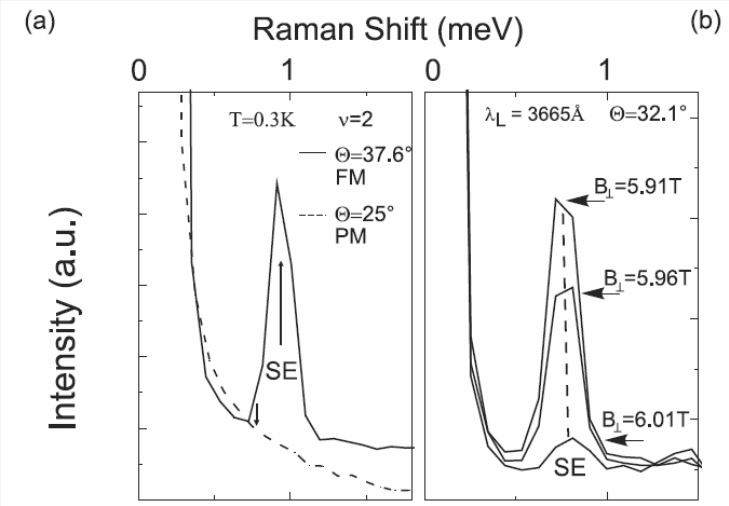
A.B. Van’kov, I.V. Kukushkin, Laboratory of Non-equilibrium Electronic Processes
- A. B. Van’kov, B. D. Kaysin, and I. V. Kukushkin
“Optical manifestation of the Stoner ferromagnetic transition in 2D electron systems”
PHYSICAL REVIEW B 96, 235401 (2017)
Nondiffusive Spin Transfer

A dense ensemble of long-lived spin-triplet excitations has been created in a 2D electron system in the magnetic field. As temperature decreases, the ensemble undergoes the transition to a new matter state – magnetofermionic condensate. In this state, spin excitations spread over huge distances (hundreds of microns and more) in a nondiffusive way. This fact opens new opportunities for manipulation of the electron system spin degree of freedom. To visualize the spread of spin excitations in the bulk of the sample studied, a novel technique of photo-induced resonant reflection has been developed.
L.V. Kulik, A.S. Zhuravlev, V.V. Solovyev, A.V. Gorbunov, V.B. Timofeev, I.V. Kukushkin, Laboratory of Non-equilibrium Electronic Processes
Observation of Azbel’-Kaner-Like Cyclotron Resonance in a Two-Dimensional Electron System
Resonant microwave absorption of a two-dimensional electron system in an AlGaAs/GaAs heterostructure excited by a near-field technique has been investigated. Along with collective magnetoplasmon modes, we have observed resonance that precisely follows the electron cyclotron resonance position and revealed no signs of a collective plasma depolarization shift. It has been shown that the discovered cyclotron mode is absent in the Faraday geometry, it is excited only in a near-field geometry, and it is localized at the edge of the exciting metal electrode. Such behavior points in favor of the single-particle nature of the discovered resonant microwave absorption which is in many respects similar to Azbel’-Kaner resonance in metals under the conditions of a non-uniform electromagnetic field realized in a near-surface skin layer.
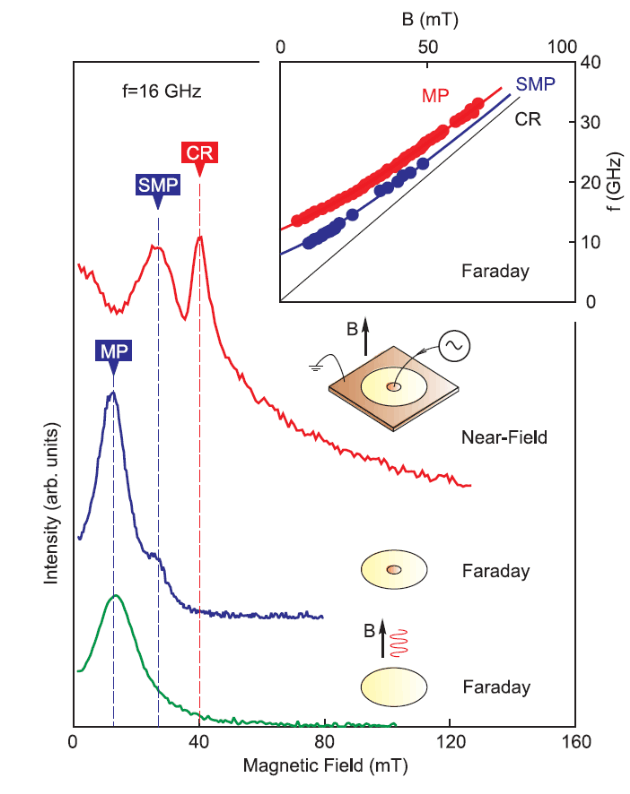 |
 |
Fundamental
magnetoplasmon (MP) and screened magnetoplasmon (SMP) are excited in
both Faraday and near-field geometries, whereas cyclotron resonance
(CR) is excited only in near-field geometry.
| |
I. Andreev, V. Muravev, V. Belyanin, I. Kukushkin, Laboratory of Non-equilibrium Electronic Processes
- I.V. Andreev, V. M. Muravev, V. N. Belyanin, and I. V. Kukushkin
”Azbel’-Kaner-like cyclotron resonance in a two-dimensional electron system”
PHYSICAL REVIEW B 96, 161405(R) (2017)
Indication of Band Flattening at the Fermi level in a Strongly Correlated Electron System
Using ultra-high quality SiGe/Si/SiGe quantum wells at millikelvin temperatures, we experimentally compare the energy-averaged effective mass, m, with that at the Fermi level, mF, and verify that the behaviours of these measured values are qualitatively different. With decreasing electron density (or increasing interaction strength), the mass at the Fermi level monotonically increases in the entire range of electron densities, while the energy-averaged mass saturates at low densities, see Figure. The qualitatively different behaviour reveals a precursor to the interaction-induced single-particle spectrum flattening at the Fermi level in this electron system.
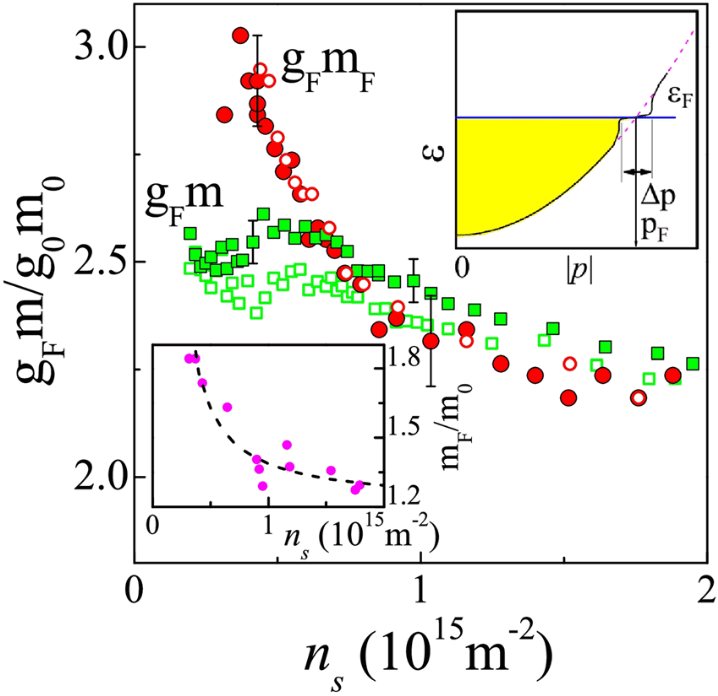
electron system in silicon, this difference can only be attributed to the different behaviours of the two effective masses. The top inset shows schematically the single-particle spectrum of the electron system in a state preceding the band flattening at the Fermi level (solid black line).
M. Melnikov, A. Shashkin, V. Dolgopolov, Laboratory of Quantum Transport
- M. Yu. Melnikov, A. A. Shashkin, V. T. Dolgopolov, S.-H. Huang, C. W. Liu, S. V. Kravchenko
Scientific Reports 7, 14539 (2017)
Renormalization of Quasiparticle Dispersion in a Two-Dimensional Fermi Liquid
The change of the low-temperature photoluminescence spectra of two-dimensional electrons in MgZnO/ZnO heterojunctions has been investigated as the electron density is decreased from 2.3 × 1012 to 3.5 × 1011 cm−2. It has been shown that the value of the quasiparticle optical density-of-states mass can be directly extracted from the width of the 2DES photoluminescence band. It has been determined that the dispersion of electrons with strong interaction undergoes sufficient renormalization, and the density-of-states mass in such a system can double the mass of a bulk material changing from 0.3 m0 to 0.6 m0. The renormalization of two-dimensional electron mass undoubtedly relates to the effects of strong electron-electron interaction since the experimental change of the electron density corresponds to a considerable variation of the interaction parameter rs which increases from 2.4 to 6.5.
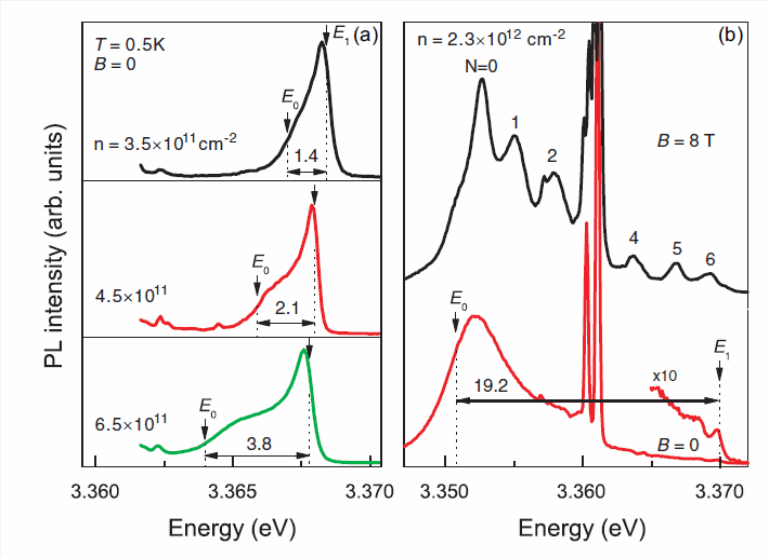
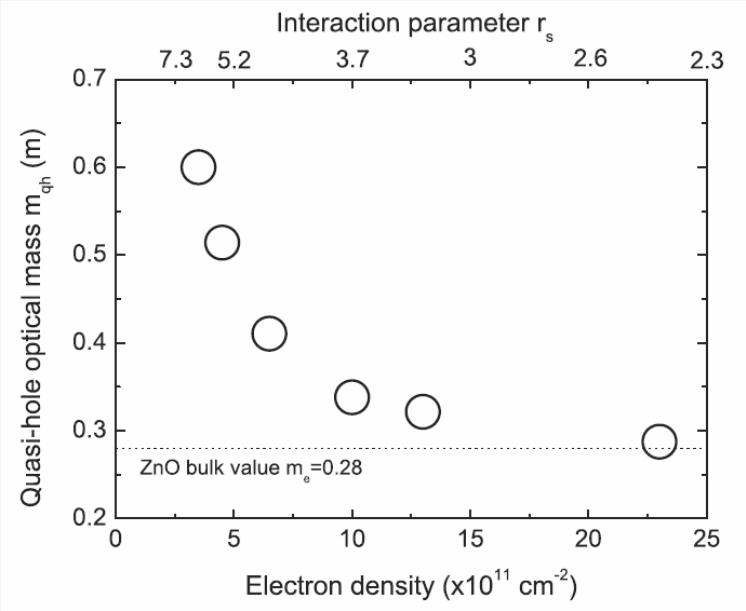
V. Solovyev, I. Kukushkin, Laboratory of Non-equilibrium Electronic Processes
- V.V. Solovyev and I.V. Kukushkin
“Renormalized Landau quasiparticle dispersion revealed by photoluminescence spectra from a two-dimensional Fermi liquid at the MgZnO/ZnO heterointerface”
PHYSICAL REVIEW B 96, 115131 (2017)
Theme 0032-2016-0003 Coherent States and Phase Transformations in Liquids and Solids
Section II. “Physical sciences”,
subsection 8. “Actual problems of condensed
matter physics, including quantum macrophycics, mezoscopy,
nanostructure physics, spintronics, superconductivity”. Programs of
fundamental scientific researches for state academies of sciences in
years 2013-2020
subsection 9.
“Material physics: new materials and structures including
fullerenes, nanotubes, graphenes, other
nanomaterials, and also metamaterials (in the fields of physics and
technologies of new functional materials for effective power
conversion”.
Programs of fundamental scientific researches for state academies of
sciences in years 2013-2020
subsection 12.
“Modern problems in radiophysics and acoustics including
fundamental principles of radiophysical and acoustic methods of
communication, location and diagnostics,
study of nonlinear wave effects”.
Programs of fundamental scientific researches for state academies of
sciences in years 2013-2020
Turbulence on a Superfluid Surface
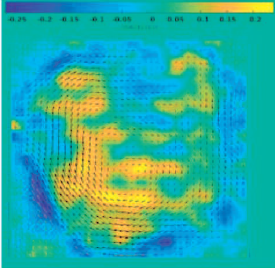
Macroscopic two-dimensional vortices have been observed on the surface of superfluid He II for the first time. It has been discovered that the interaction between noncollinear Faraday waves on the surface of He II in a rectangular cell can lead to the appearance of a periodic lattice of not only gravity-capillary waves, but vortices, as well as on the surface of a classic fluid, for instance, water.
Pel’menev A.A., Levchenko A.A., Mezhov-Deglin L.P. Laboratory of Quantum Crystals
Nanovoids in Shear Bands of Amorphous Alloys

The method of relaxation of the free volume in amorphous alloys by the formation of nanovoids in a shear band has been discovered. Application of the Кirchner approach for growth kinetics of second phase precipitation at the phase boundary for the analysis of nanovoids growth has permitted to determine the value of the effective diffusion coefficient in the shear band at room temperature. This value was approximately D ~10-22m2c-1 for aluminum-based amorphous alloy that is greater by 6 orders of magnitude than the corresponding value of the diffusion coefficient in an amorphous matrix. Such a high value of the diffusion coefficient at room temperature is of principal importance for estimation of the stability of deformed amorphous and nanocrystalline alloys.
A.S. Aronin, Laboratory of Structural Research
- Aronin, D.V., Louzguine-Luzgin,
On nanovoids formation in shear bands of an amorphous Al-based alloy
MECHANICS OF MATERIALS, 113 (2017) 19-23, DOI: 10.1016/j.mechmat.2017.07.007.
Synthesis of Tantalum Dihydride
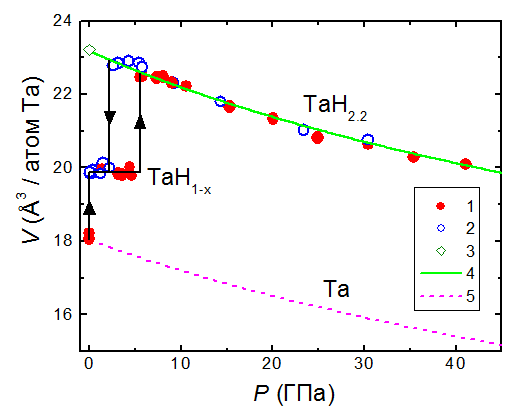
Tantalum dihydride has been synthesized at high hydrogen pressures. In contrast to presently known dihydrides of other metals of groups IVB and VB (Ti, Zr, Hf, V and Nb) with a face-centered cubic structure synthesized at about ambient pressures tantalum dihydride is formed at pressures above 5.5 GPa only, it has an unusual close-packed hexagonal structure and superstoichiometric composition H/Ta = 2.2. The hydrogen content has not been experimentally determined in any other high pressure hydride, obtained over the past 18 years. (ISSP RAS, IPC PAS, MSU)
- M.A. Kuzovnikov, M. Tkacz, H. Meng, D.I. Kapustin, V.I. Kulakov
“High-pressure synthesis of tantalum dihydride”,
Phys. Rev. B 96 (2017) 134120-1–134301-6.
M. Kuzovnikov, V. Kulakov, Laboratory of High Pressure Physics
Laws of the Magnetization Reversal Process of Nanocluster Films
The laws of the magnetization reversal process of Pd0.99Fe0.01 nanocluster films have been investigated experimentally and by the method of numerical simulation. The two-component behaviour of their magnetization has been determined, anomalous magnetic relaxation in such heterostructures has been discovered. It has been shown that 20-40 nm-thick films have the properties necessary for their use in spintronics elements: nanocluster ferromagnetic subsystem does not suppress niobium superconductivity and provides magnetization switching due to processes of rotation with low coercivity and characteristic time of the order of 10-10 second. The magnetic relaxation observed in Pd0.99Fe0.01 thin films does not prevent their use in devices since it is observed only after magnetic field switching.
Pd0.99Fe0.01 weakly ferromagnetic alloys are considered as a promising material for realization of Josephson magnetic memory based on rapid single quantum logic (Rapid Single Flux Quantum logics). The processes of magnetization reversal in them determine the speed of digital state recording of the developed elements.
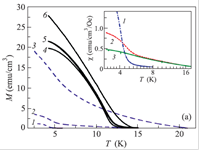
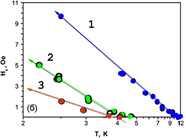

- L.S. Uspenskaya, I.V. Shashkov,
Influence of Pd0.99Fe0.01 film thickness on magnetic properties.
Physica B DOI information: 10.1016/j.physb.2017.09.089.
L.S. Uspenskaya, O.A. Tikhomirov, I.V. Shashkov, V.V. Bol’ginov, Laboratory of Real Structure of Crystals, Laboratory of Superconductivity
Theme 0032-2016-0004 Physics and Technologies of New Materials and Structures
Section II. “Physical sciences”,
subsection 8.
“Actual problems of condensed
matter physics, including quantum macrophycics, mezoscopy,
nanostructure physics, spintronics, superconductivity”. Programs of
fundamental scientific researches for state academies of sciences in
years 2013-2020
subsection 9.
“Material physics: new materials and structures including
fullerenes, nanotubes, graphenes, other
nanomaterials, and also metamaterials (in the fields of physics and
technologies of new functional materials for effective power
conversion”.
Programs of fundamental scientific researches for state academies of
sciences in years 2013-2020
Spin-Filtering Effect in Nanostructured Graphene Synthesized on SiC/Si(001) Wafers
Large positive magnetoresistance has been discovered in nanostructured graphene synthesized on cubic silicon carbide thin films epitaxially grown on standard Si(001) wafers. It has been shown that graphene layer rippling near domain boundaries leads to one-dimensional conductivity (along the domain boundaries) at low temperatures and accumulation of electrons with a particular spin direction at the boundaries. The obtained results demonstrate the feasibility of fabricating new nanostructures with unique properties on the technologically relevant SiC/Si(001) wafers. These substrates are fully compatible with existing silicon technologies and can be adapted for production of novel electronic and spintronic devices based on graphene

- Wu H.-C., Chaika A.N., Aristov V.Yu., Molodtsova O.V., Babenkov S.V., Molotkov S.N. et al.,
Large positive in-plane magnetoresistance induced by localized states at nanodomain boundaries in graphene,
Nature Communications 8, 14453 (2017)].
V.Yu. Aristov, A.N. Chaika, S.N. Molotkov (LSSS)
Phase Transitions under Severe Plastic Deformation
By the example of two Cu-Al-Ni alloys with shape memory, it has been shown that martensite (diffusionless) phase transitions can occur in combination with diffusion ones under severe plastic deformation. Thus, diffusion transformations in these alloys caused by high pressure torsion (HPT) influence the following martensite transformation. To be exact, HPT of these alloys led to precipitation of α1-phase in the first case and γ1-phase in the second case from the solution (as if these alloys had been subjected to annealing at effective temperature Teff = 620±20°C). As a result, after HPT both alloys contained mainly β'3 martensite with some quantity of γ'3 martensite. The obtained results open new opportunities for the use of shape memory and superplasticity effects in Cu-Al-Ni nanostructured alloys.
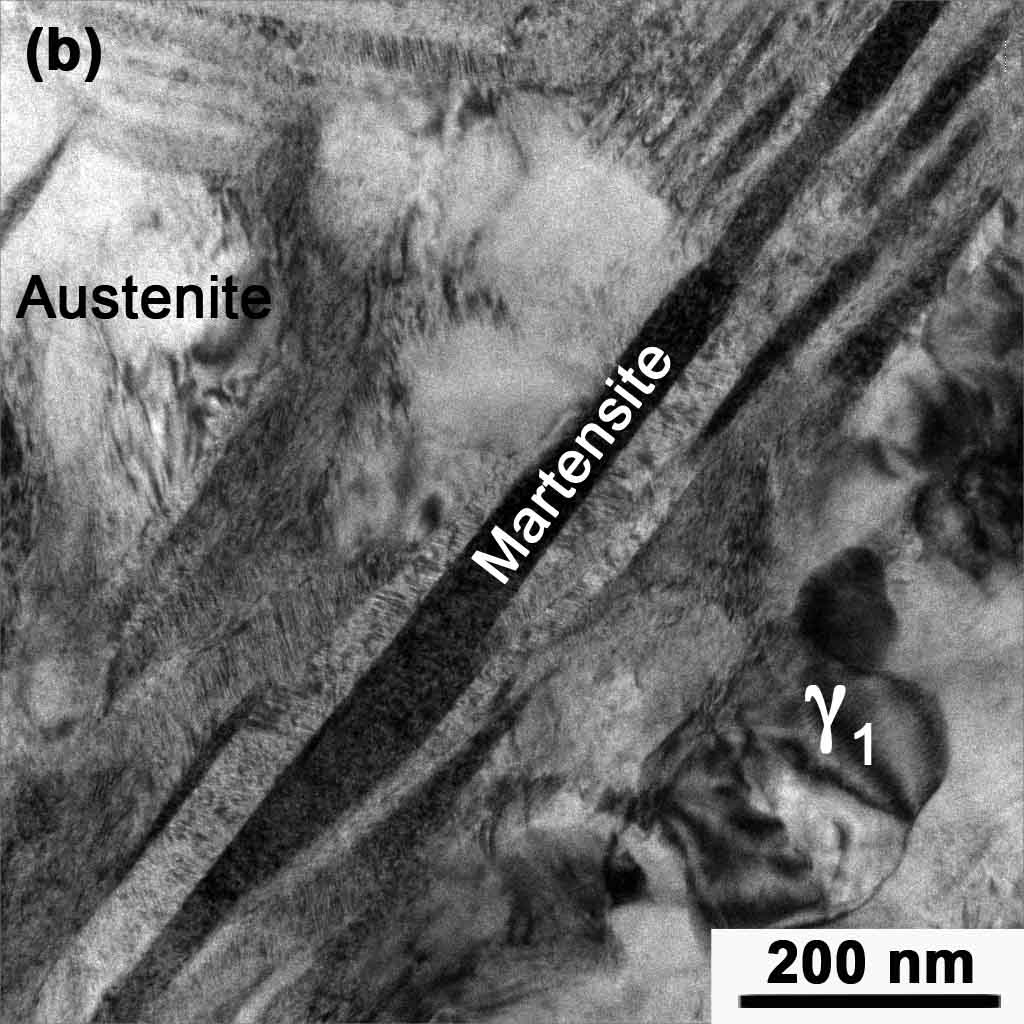
B.B. Straumal, O.A. Kogtenkova, A.A. Mazilkin, Laboratory of Internal Boundaries in Metals, Sector of the Elemental and Structural Analysis
Technology of Fibrous Composites
The technology of silicide-molybdenum and oxide-molybdenum fibrous composites has been invented in the Laboratory of Reinforced Systems. The development of this technology permits creating materials for key elements of gas turbines, such as blades operating at temperatures up to 1400оС which exceeds the use temperature of existing nickel alloys by 300оC and is higher by 100оC than that for molybdenum alloys being under development by research centers abroad. Operating capacity of the composites is determined by their high fracture toughness (Fig. 1), creep resistance (Fig. 2) and enhanced gas corrosion resistance (Fig. 3). The use of such composites as gas-turbine engine materials will provide a significant increase in engine efficiency and reduction of harmful emissions to the atmosphere.
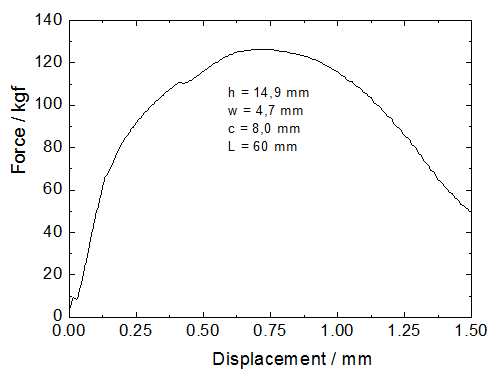
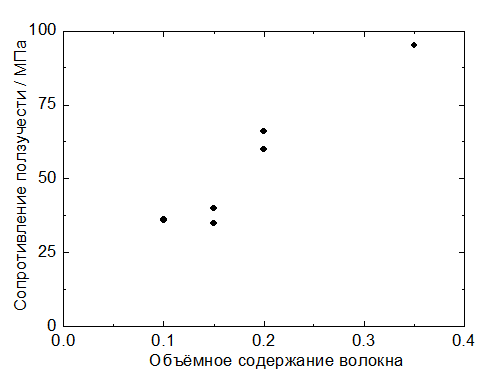

- S.T. Mileiko,
High temperature oxide-fibre/metal-matrix composites,
Materials Chemistry and Physics (2017)
Mileiko S.T., Novokhatskaya N.I., Laboratory of Reinforced Systems




